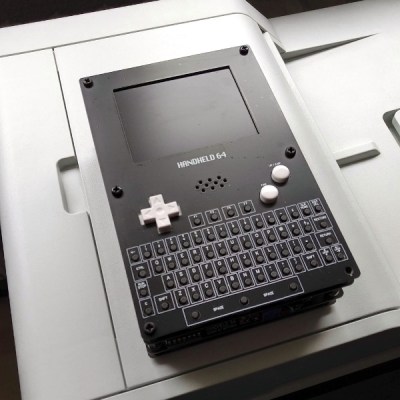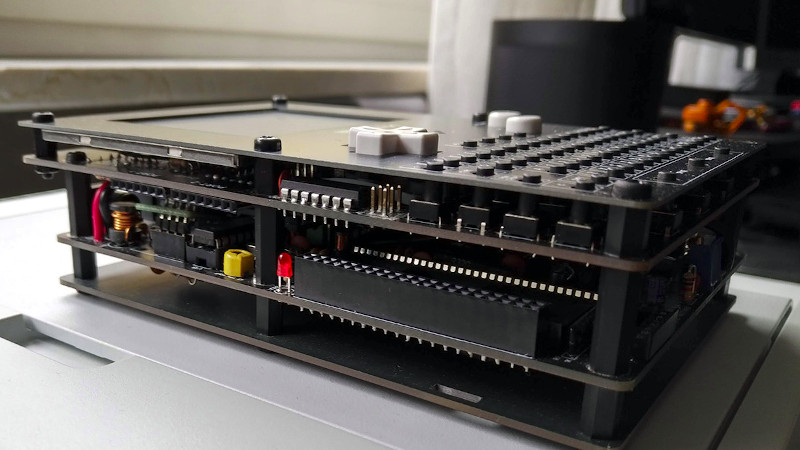It’s now nearly four decades since the iconic Commodore 64 8-bit computer saw the light of day, and the vintage format shows no sign of dying. Enthusiasts have produced all kinds of new takes on the platform, but it’s fair to say that most of them have concentrated on the original style keyboard console form factors. A completely different take on a Commodore 64 comes from [UNI64] in the form of the Handheld 64, a complete Commodore 64 in a Game Boy style form factor that uses the original 64 chipset.
 It achieves this improbable feat by sandwiching together several PCBs, with a tactile switch keyboard and LCD display at the top. It appears to bring the 64 ports out to headers, and the ROM cartridge port to an edge connector socket at the top of the device. A departure from the 1980s comes in using a Raspberry Pi Zero to emulate a 1541 floppy drive though.
It achieves this improbable feat by sandwiching together several PCBs, with a tactile switch keyboard and LCD display at the top. It appears to bring the 64 ports out to headers, and the ROM cartridge port to an edge connector socket at the top of the device. A departure from the 1980s comes in using a Raspberry Pi Zero to emulate a 1541 floppy drive though.
Sadly unlike a Game Boy there’s no onboard battery, but don’t let that take away from the quality of this feat. A forum post from [3D-vice] has a set of decent-quality pictures, and even if you don’t have a handy 64 chipset lying about we’re sure you’ll still appreciate them. If home made 64s are your thing, take a look at how you can build one without Commodore parts.
Thanks [pbuyle] for the tip!















It’s a work of art.
If only it was Commodore Beige it would be perfect.
Nice achievement. A bit more practical thing to shoot for in the way of a portable Commodore 64 would be a laptop form factor using a modern color flat panel display. Would then be able to easily add modern lithium-ion battery pack to give it true portability
Am thinking the Tandy Model 200 would make an excellent mid 80s retro laptop form factor to copy for such a project (which I happen to own a working Tandy Model 200 – too bad I lack all the other resources and skills to do such a project).
Bought the Model 200 thinking one day might try to capture its case design in some 3D modeling software, but given that it still works, I didn’t have the heart to tear it all the way down to constituent components out of fear I might not be able to restore it back to working condition.
Well if you want the original C64 laptop just get an SX64, but you need a pretty damn big lap! But I think if you want inspiration for a “modern” C64 laptop you should model it, somewhat, after the Commodore LCD, a Commodore experiment in the Tandy 200 style, check it out.
https://www.c64-wiki.com/wiki/Commodore_LCD
Well, the Tandy Model 200 looks way better than that form factor – the Model 200 has a seemingly larger screen size area for one thing that doesn’t look so dis-proportioned, and the Model 200 actually has a decent keyboard (is pretty much same as the Model 100 for the most part and journalist seemed to get on rather well with the Model 100 keyboard)
Tandy Model 200
http://munk.org/typecast/wp-content/uploads/2018/07/DSC02142.png
Depends on which photo you are looking at. Link below shows an image of it where the keyboard looks more modern than the Model 200 one and the screen size looks to be nearly identical. The major key with the Commodore model is they were building all of their own components, including the LCD panel, so their price point could have been quite impressive. Shame they decided to build the C128 instead.
https://www.c64-wiki.com/wiki/File:CLCD_top.png
Oh, I like the Model 200, no doubt, but I think if you are going to make a modern C64 portable getting your design cues from Commodore is the way to go, and the keyboard of the CLCD looks like it was made for the C64, just enlarge the monitor a little, ala Model 200. And as “Johnmichael Monteith” said, imagine Commodore made the CLCDm could have put them on a different track, imagine an Amiga laptop?
Uni64 has several c64 motherboards, including a 184x146mm “portable” one. Not a full laptop but maybe enough for an adventurous tinkerer to start a new project.
https://www.uni64.com/en/p/64-micro-laptop-v2
Cool! I hope it has the cassette interface, too! Would be nice to attach some RTTY interface to that. :)
That would be incredible!
I must have one.
Power the whole thing off the 20mA current loop for bonus points.
Cute idea, but 20mA is nowhere near enough for the whole machine, you couldn’t power an atmega328p blinking an LED with that. Maybe you could use the extra current with a capacitor bank and a charge pump to recharge a secondary battery though
Why ask why? Bud dry.
I think this project was inspired by Chris Simpson (Perifractic’s Retro Recipes on YouTube) idea to make a handheld C64 after he picked up a Nintendo Switch.
They were computers that a single person could come to understand pretty much any aspect of – one of those computers could fit in one’s head, IOW.
Well, consider how David Murray – the Youtuber known as The 8-Bit Guy – he’s produced two very high quality games that can run on 8-bit computers like the Commodore 64 (and the PETs, the Apple II, and early MS-DOS computers ala the Tandy 1000). He doesn’t have a computer science degree or an EE degree. He does have a lot a passion for these kind of computers from his youth. He’s completely self-taught in all the skills he brought to bear on developing these games. These games can be purchased in packaging with manuals, illustrative artwork, sound track – all of it comparable to any of the commercial offerings for those 8-bit computers from back in the day.
Creation like that is the ultimate enjoyment – playing a game is a completely downstream, derivative experience that doesn’t even begin to compare to the satisfaction from the creative process that it takes to make those games.
In contrast to today (or the last 20 years), it takes lots of people with lots of resources and lots of diverse technical knowledge and capability to deal with modern computers and/or game consoles – to do things like produce what are considered quality games for them. Most people are therefore just left with the experience of being a game player and nothing else.
The retro computers are at a scale of complexity such that anyone could go and do what David Murray did if they chose to do so – be a creator instead of just a player. That’s the thing we miss about those early computers.
Well said!
+1, nailed it.
Why are so many people fixated on ‘progress’? Most new ideas are bad ideas anyway.
Can Zork be far behind.
You can still find Commodore DTV’s on eBay. Not perfect. but tiny.
Thank you Jeri and gang!
Any idea what LCD panel & driver is being used? I can’t find that info anywhere on the uni64 website or other linked forums/docs.
I you register to loop64, the Handled64’s author own forum, there is a components list topic which reference https://de.aliexpress.com/item/1005001600487891.html
Very nice job! I would love to have a handheld Commodore 64!